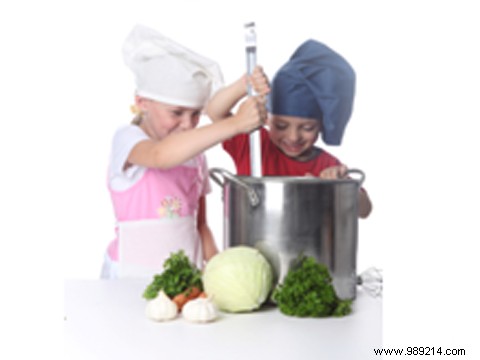In all the households of the world, a guerrilla has been raging since the dawn of time, opposing two belligerents firmly entrenched in their positions. On the one hand the parents, who full of good intentions want their toddlers to enjoy all the benefits provided by vegetables. On the other, the children, convinced that the only purpose of this relentlessness is to annoy them, perhaps even to punish them, by imposing on them plates filled with spinach, salsify, and even broccoli!
Parents, do not despair, this stubbornness against green vegetables is not just a whim intended to complicate your life. Specialists explain the origin of this aversion. Armed with this information, we will be better able to find solutions, and to know how to tame the fork of our cherubs by teaching them to like vegetables.
For each problem there is a solution.
You should know that children, not yet benefiting from personal experience, have a much more instinctive functioning than adults. This also applies in the food sector. The child bases himself on what he knows, and on what his instinct tells him. However, vegetables give off signs, clues, which for him are not synonymous with "good".

First, green vegetables are often bitter, which in the unconscious takes on the appearance of a "Danger" sign. Indeed, in nature a bitter taste is often the sign of the presence of poison. Bitterness is therefore a taste to which the taste buds must be educated so that they learn to appreciate it. It's not a child's taste. For example, as children we all hated coffee, whereas today many of us have become addicted to it.
So don't force your child to swallow a cast of endives overnight, get them used to it gradually by combining a few bits of endive in a slightly sweeter dish, such as beets. You can also toss some bell peppers and broccoli into a plate of pasta. The whole thing is to combine a small amount of vegetables (which will grow over time) with a flavor that the child appreciates more.
Going in the same direction, the "green" color of the vegetables which reinforces this idea of "bad". Green refers to rot, or unripe. The symbolism of colors is something very powerful and will greatly influence our emotions and our perception. All the more so in children.
To overcome this, we will have to play on the presentation of the dish, make it more friendly, try to make it look like a food that the little man likes. Lie ? No, just…improving the truth, for example by cutting certain vegetables into strips similar to tagliatelle. The goal is simply to make people forget the color by focusing on the shape.
Moreover, vegetables are very simple foods, which has two consequences on the perception of children. First, from a purely instinctive and unconscious point of view, the child does not have the impression that this "light" food will be able to nourish him sufficiently, or meet his need for food. From a more contemporary point of view, this simplicity is the opposite of all the images that the child sees in advertisements. Compared to all the products filled with colors and in various shapes that he sees on TV, the vegetable seems very bland and uninteresting to him. After all, "why does the little boy with the bright face on TV get donuts in the shape of a clown, when I'm afflicted with this horrible mash of questionable color..? "
There is no miracle recipe, you will have to either completely cut your child off from the rest of the world, which all the same seems a bit radical for a plate of beans, or show great imagination to compete with all the dishes in shape of toys presented in advertising (the most likely solution, we will all agree). Drawing a man in the mash, making themed meals such as "an all red meal" or "all green", the goal is to think in a playful way to make the meal a moment of pleasure and enthusiasm.
In addition, the child is in full learning of his environment. When he sees a new food, all of his senses automatically adjust to "wary", it's sort of the default setting. Faced with a new food, the child will therefore directly classify it as a "potential problem".
The principle is therefore to help the child overcome this first feeling. To do this, he must be able to appropriate it using his other senses:let him touch and feel it. You can even offer to help you cook it, the young cook will surely be proud and impatient to taste the dish he made with his hands with the help of his dad or his mom.
Finally, the little ones have the annoying tendency to want to say no to everything, for no particular reason. And if mom and dad seem to attach importance to it, it's even more interesting to say the opposite! If this spirit of contradiction is somewhat annoying, it is nevertheless normal. This is the period through which we have all passed and which reflects a need to impose oneself as an individual.
There, no solution in the kitchen. The best tactic is probably not to overwhelm him with phrases like "eat your carrots! It's good for your health!" who will be more likely to put him off carrots for life than anything else. In this case, only the authority of the parents has a role to play.